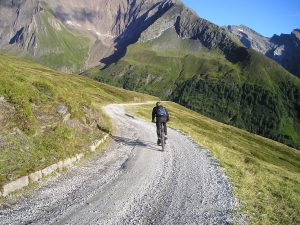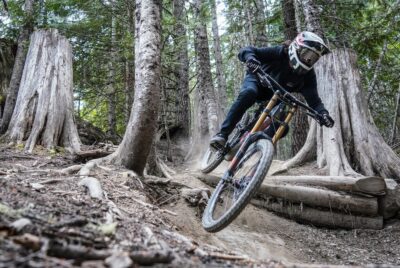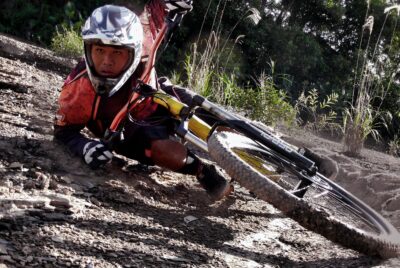Beginner’s Guide to Mountain Biking
Introduction
As an enthusiastic mountain biker, I’m excited to share this beginner’s guide to mountain biking, where I’ll provide valuable suggestions and reasons to help you get started on your thrilling mountain biking journey.
Mountain biking is an exhilarating outdoor activity that allows you to explore nature, challenge yourself physically, and experience the freedom of riding on off-road trails. Whether you’re seeking adventure, fitness, or a new hobby, mountain biking offers a thrilling and rewarding experience. In this guide, we’ll cover the basics of mountain biking, from essential gear to trail etiquette, to ensure you have a safe and enjoyable ride.
1. What is Mountain Biking?
Mountain biking involves riding bicycles specifically designed for off-road terrain. It differs from road cycling as it takes place on natural trails, including forests, mountains, and rugged landscapes. Mountain bikes are equipped with features like suspension systems, knobby tires, and sturdy frames to handle the challenges of uneven surfaces and obstacles.
2. Benefits of Mountain Biking
Mountain biking offers numerous benefits for both your physical and mental well-being. It provides an excellent cardiovascular workout, strengthens your leg muscles, and improves overall endurance. Additionally, spending time in nature and the adrenaline rush from conquering trails can reduce stress and boost your mood.
3. Essential Gear for Mountain Biking
Before hitting the trails, it’s crucial to have the right gear for a safe and enjoyable ride. Here are some essential items to consider:
Helmet
A properly fitting helmet is a must to protect your head in case of falls or accidents. Look for helmets designed specifically for mountain biking with adequate ventilation and impact protection.
Protective Clothing
Wearing lightweight, breathable clothing can keep you comfortable during rides. Consider padded shorts, moisture-wicking jerseys, and gloves for added protection and grip.
Shoes and Pedals
Invest in a pair of mountain biking shoes with a stiff sole for efficient power transfer. Pair them with pedals that provide good traction and allow for easy release.
Eye Protection
Protect your eyes from dirt, debris, and branches by wearing sunglasses or clear goggles. They also provide UV protection and improve visibility in different light conditions.
Tools and Repair Kit
Carry a basic toolkit and repair kit containing items like tire levers, spare inner tubes, a pump, and a multi-tool for on-trail repairs.
4. Finding the Right Mountain Bike
Choosing the right mountain bike is essential for a comfortable and enjoyable ride. Consider the following factors when selecting your bike:
Bike Types
There are various types of mountain bikes, including cross-country, trail, enduro, and downhill bikes. Each type is designed for specific terrains and riding styles. Research and test ride different models to find the one that suits your needs.
Frame Size and Fit
Ensure your bike’s frame size is appropriate for your height and body proportions. A properly fitted bike will provide better control and reduce the risk of injuries.
Suspension
Decide whether you need a hardtail (front suspension) or full-suspension bike (front and rear suspension) based on the type of trails you’ll be riding. Full-suspension bikes offer better comfort and control on rough terrain but tend to be more expensive.
Components
Pay attention to the components of the bike, such as brakes, gears, and wheels. Opt for reliable and durable components that suit your riding style and budget.
5. Basic Mountain Biking Techniques
To ride with confidence and control, mastering some basic mountain biking techniques is essential. Here are a few fundamental skills to focus on:
Body Position
Maintain a balanced and neutral body position on the bike, with knees and elbows slightly bent, and weight centered over the pedals. This allows you to absorb bumps and maintain stability.
Braking
Learn to use your brakes effectively, using both front and rear brakes to control your speed. Avoid locking up the wheels to prevent skidding and maintain control.
Shifting Gears
Understand how to shift gears smoothly to maintain an optimal cadence. Anticipate changes in terrain and adjust gears accordingly to make climbing and descending easier.
Cornering
Practice proper cornering technique, leaning your bike and body into turns while looking ahead to maintain stability and control.
Climbing and Descending
Master climbing techniques such as weight distribution, maintaining momentum, and using lower gears. For descents, learn to shift your weight backward, use controlled braking, and choose the best lines to navigate obstacles.
6. Safety Tips for Beginner Mountain Bikers
Safety should always be a top priority when mountain biking. Follow these tips to ensure a safe riding experience:
Ride Within Your Skill Level
Start with beginner-friendly trails that match your current skill level. Gradually progress to more challenging terrain as you gain experience and confidence.
Wear Protective Gear
Always wear a helmet and appropriate protective gear. Consider knee and elbow pads, as well as a back protector for added safety.
Ride with a Buddy
Whenever possible, ride with a companion. Having someone with you enhances safety and provides assistance in case of emergencies.
Know and Follow Trail Rules
Familiarize yourself with local trail rules and regulations. Respect trail closures, yield to hikers and equestrians, and leave no trace by packing out your trash.
Stay Hydrated and Fuel Up
Carry enough water and snacks to stay hydrated and energized during your ride. Proper nutrition and hydration are crucial for endurance and focus.
7. Exploring Beginner-Friendly Trails
When starting out, choose beginner-friendly trails that offer a mix of easy terrain and scenic views. Look for trails with gentle slopes, wide paths, and fewer technical obstacles. Local trail maps, online resources, and mountain biking communities can provide valuable information on suitable trails for beginners.
8. Joining Mountain Biking Communities
Connecting with other mountain biking enthusiasts can enhance your experience and provide valuable guidance. Join local mountain biking clubs or online communities to find riding buddies, attend group rides, and gain insights from experienced riders.
9. Building Skills and Progressing as a Rider
Mountain biking is a lifelong learning process. Continuously challenge yourself by practicing new skills and exploring different types of terrain. Take advantage of skills clinics or lessons offered by experienced riders or coaches to improve your technique and gain confidence.
10. Staying Motivated and Overcoming Challenges
Mountain biking can present physical and mental challenges, but overcoming them can be incredibly rewarding. Set achievable goals, celebrate your progress, and remember to have fun along the way. Surround yourself with supportive riders who encourage and motivate you to keep pushing your limits.
11. Understanding Trail Etiquette
Respecting the trails and other trail users is essential for a positive mountain biking experience. Follow these trail etiquette guidelines:
Yield to Others
Yield to hikers, runners, and equestrians. Slow down and give them the right of way, particularly on narrow trails.
Control Your Speed
Ride at a speed that allows you to maintain control at all times. Slow down in crowded areas and when approaching blind corners.
Leave No Trace
Minimize your impact on the environment by staying on designated trails, avoiding sensitive habitats, and packing out your trash.
Communicate and Be Courteous
Use audible signals, such as a bell or voice, to alert others of your presence. Be friendly, greet fellow trail users, and offer assistance when needed.
12. Maintenance and Care for Your Mountain Bike
Proper maintenance ensures your mountain bike performs optimally and prolongs its lifespan. Regularly perform the following tasks:
Clean Your Bike
After each ride, clean your bike to remove dirt, mud, and debris. Pay attention to the drivetrain, brakes, and suspension components.
Check Tire Pressure
Maintain appropriate tire pressure based on trail conditions. Insufficient pressure can lead to pinch flats, while excessive pressure reduces traction.
Lubricate Moving Parts
Apply lubrication to the chain, derailleurs, and other moving parts to reduce friction and ensure smooth shifting and pedaling.
Inspect and Tighten Bolts
Regularly inspect your bike for loose or damaged bolts. Check the stem, handlebars, seat post, and other critical components.
Get Professional Servicing
Schedule periodic professional servicing to address more complex maintenance tasks, such as fork and shock service, brake bleeds, and drivetrain adjustments.
13. Preparing for Your First Mountain Biking Adventure
Before embarking on your first mountain biking adventure, make sure you’re fully prepared:
Plan and Research
Research the trail you’ll be riding, including distance, difficulty level, and any specific requirements. Plan your route and inform someone about your itinerary.
Pack Essentials
Carry a small backpack with water, snacks, a first aid kit, a map or GPS device, a multi-tool, and a spare tube or patch kit.
Dress Appropriately
Wear weather-appropriate clothing and consider layering to adapt to changing conditions. Bring a waterproof jacket and extra clothing in case of unexpected weather changes.
Warm-Up and Stretch
Before starting your ride, warm up your muscles with some light exercises and stretches. This helps prevent injuries and prepares your body for the physical demands of mountain biking.
Start Slow and Pace Yourself
Begin your ride at a comfortable pace, allowing your body to adapt to the terrain. Take breaks as needed and listen to your body’s signals to avoid overexertion.
Conclusion
Congratulations on exploring the beginner’s guide to mountain biking! By following these suggestions and taking the time to build your skills and knowledge, you’ll embark on a thrilling journey that offers adventure, fitness, and a deep connection with nature. Remember, the key is to start at your own pace, stay safe, and enjoy every moment on the trails.
FAQs
1. Can I start mountain biking if I have no prior cycling experience?
Absolutely! Mountain biking can be enjoyed by beginners with no prior cycling experience. Start with beginner-friendly trails and gradually progress as you gain confidence and skills.
2. Do I need an expensive mountain bike to get started?
While high-end mountain bikes offer advanced features, you don’t need to invest in an expensive bike as a beginner. Choose a bike that fits your budget and suits your riding style.
3. How can I improve my balance and bike handling skills?
Practice is key. Start with basic balance exercises and gradually progress to more challenging maneuvers. Skills clinics or lessons can also provide valuable guidance.
4. Are there any age restrictions for mountain biking?
Mountain biking can be enjoyed by people of various ages. However, it’s essential to assess your physical fitness and consult a healthcare professional if you have any concerns.
5. Can I mountain bike in any weather conditions?
While mountain biking is often done in fair weather, you can ride in various conditions. Just ensure you have the appropriate gear, and adjust your riding style according to the terrain and weather.
Remember, mountain biking is an adventure, so embrace the journey, challenge yourself, and have fun exploring the trails!




